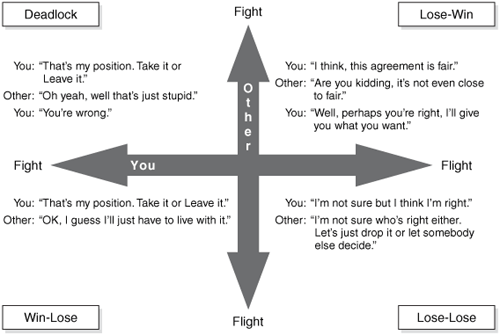Negotiation Styles
Before we explore the Negotiation Style Model, be sure you have taken the Negotiation Style Survey in Appendix A.
The building of our Negotiation Style Model[2] begins with basic psychology and the primal responses to conflict. Generally, people respond by displaying the classic extremes of fight or flight. In Figure 7.2, we see these two responses laid out on a continuum.
Figure 7.2. Fight-Flight Continuum
![]()
Focusing on conflict expressed in verbal conversations, here are the characteristics of fight versus flight:
| Characteristics of Fight | Characteristics of Flight |
|---|---|
|
|
|
|
|
|
|
|
|
|
In responding to conflict, neither of these extremes works well. The fight response focuses on me—my needs, position, and so on. By pounding on my position and my issues, the relationship is often damaged. However, the flight response abandons the issues in service of saving the relationship or avoiding the pain of confrontation.
Imagine the dialogues that would occur if two parties were operating at the two extremes (see Figure 7.3).
As shown in Figure 7.3, fight-fight usually results in a heated argument, with neither party coming out ahead, and ends in a deadlock—a ...
Get Practical Negotiating: Tools, Tactics & Techniques now with the O’Reilly learning platform.
O’Reilly members experience books, live events, courses curated by job role, and more from O’Reilly and nearly 200 top publishers.


